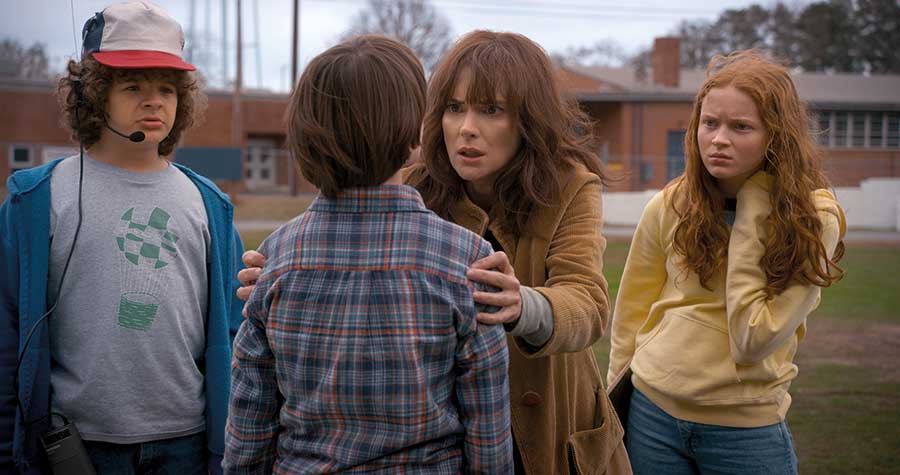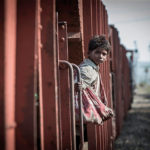
Stranger Returns
Posted on Nov 8, 2017 by Julian Mitchell
Season two of the wildly popular Stranger Things is upon us and we talk to the main DOP Tim Ives about mixing an eighties look with modern filmmaking techniques
DOP Tim Ives was nominated for an Emmy award for his cinematography on Stranger Things, season one, and more specifically for the eighth episode called ‘Upside Down’. The official award was a nomination for OUTSTANDING CINEMATOGRAPHY FOR A SINGLE-CAMERA SERIES (ONE HOUR).
Those of you who have a Netflix subscription might know this great sci-fi adventure, which harks back to some classic films of the seventies and eighties such as Close Encounters of the Third Kind and E.T. the Extra Terrestrial. Stranger Things manages to reference those movies without imitating them; the influence of Spielberg is all over the episodes – but with much reverence.
 Although technically a single-camera show, a B camera was used for more dramatic moments
Although technically a single-camera show, a B camera was used for more dramatic moments
From the start, Stranger Things was a RED camera shoot and the Dragon was the choice for season one, but come the planning for the new season Tim Ives looked for something new from the Californian camera company. “We had the RED Dragon in season one and then the Helium became available to us in the fall of last year. We tested it against the Dragon and other cameras, and we just felt it gave us more opportunities for night time work than the Dragon did, so we switched it over but kept the same lenses, which are the Leica Summilux-C range. Last year we were 7K to 6K extraction and for this season we were looking at 8K to 7K extraction.
“The new RED Helium made the look a little less muddy, it seemed a little clearer and little more filmic, and it also allowed me to shoot a very high ASAs – 1600 to 2000 – when I needed to. I do like lighting with practicals but when you’re on a city street with just street lights, 1600 or 2000 really goes a long way in capturing an image that looks quite natural. We do very slight filtering in camera – I can’t say which one but it softens it down a little bit and also blooms the lights as well. I wanted to find something subtle for the show that would work for night-time and for interiors. I have one little filter that takes the lights and creates a halation around them. We also use atmosphere or haze quite a bit in order to catch flash lights and extend highlights, that kind of thing. That’s one of the main looks of the show, I would say.”
Spielberg movement
 The eighties films of Steven Spielberg are a defining influence on the production.
The eighties films of Steven Spielberg are a defining influence on the production.
Spend just a little time in the Stranger Things world and things feel very familiar. The big, sweeping technocrane moves are straight from the Spielberg playbook, and of course that’s all on purpose. “We really like camera movement but the mantra is that it has to tell the story and move the story forward; every scene has been written to be exciting, so we need to use technology to accentuate that narrative. Every move of the camera is with intent to tell the story; we got better at doing that in the first series as the season went on.
“We understood the show more, and season two has benefitted from that. We have the 50-foot technocrane quite frequently aboard a four-wheel drive vehicle that can go anywhere. We used the techno for sweeping landscapes and for moving the actors around; there’s a lot of running and biking in Stranger Things and that piece of equipment really helped us a lot. Other than that, we were always on the dolly, we were very rarely handheld. It’s more of what we loved from season one – we haven’t really changed the game, we just know our show a little bit better.
“We don’t really use jib arms so much for camera movement as they’re not as flexible as the technos; we’ll use the baby techno up to the 50-foot one when we need it. In season one we had all those shots of the quarry and others. Our A camera operator Bob Gorelick also is a great steadicam operator and we pull that out when we just have to do it, or when the dolly’s not working and we have multiple characters in a house. We’ll use steadicam in the Byers house when we’re chasing people around. But we use the dolly very technically by hitting marks, turning it around, spinning it. It’s done in a very classic way. Chris Chapman is our dolly grip and he’s just remarkable, he should be in the camera guild as a camera operator with what he does with that dolly. For instance, the first time you see Chief Hopper in season one it’s an almost 360 degree move in his trailer which goes from his kitchen to his living room, to him passed out on the couch. In that move you come across a refrigerator, you see a little kid’s drawing, a table with empty beer cans and cigarettes, then you come up over the carpet where there are things tipped over and up to the chief. That shot was done in one shot on a dolly, he started and stopped the dolly twice and you would never notice it. It’s using the same technology that might have been used in the seventies or eighties. We do these complicated dolly moves quite frequently.”
Movie principles
 Season two sees more location work, as the Stranger Things universe is further explored.
Season two sees more location work, as the Stranger Things universe is further explored.
Schedule-wise and how they shoot is definitely akin to shooting a film; in fact you shouldn’t call this a television show. “In season two especially, every episode is like a movie – out of nine episodes we basically made four-and-a-half movies, it was that intense. The episodes are really not shot in the television sort of way, that was the Duffer Brothers’ instinct and that’s the way they like to tell stories. I see them more as feature directors than television directors. That’s half the attraction for me, being able to put something on the screen that can really hold its own in a theatre. I’ve seen the show projected in a theatre and there’s nothing small about it, it really holds up. I think the Duffer Brothers write movies.
“We have a lot of standing sets for the interiors and there are duplicates for the exteriors. We have the Wheeler houses, which is Mike Wheeler’s home with the basement where they play Dungeons & Dragons, that’s all interior. The Byers house, Joyce and Will. There’s also the interior of the lab where the ‘rift’ is, we use locations interior and exterior to expand on that in Atlanta.
“We’re not in the stages all the time; this show really comes to life when we get these characters out on the streets and that’s really fun to do because it’s period. The stage work is really fun, there’s a lot of mystery to it, especially in the lab in season one – in particular the last episode, which I’m nominated for. I would say it’s 30 to 40% stage and the rest location for the first season, and probably more outside for season two.
“It’s technically called a single camera show but that allows for two cameras: although we work with A quite a lot we bring in B camera when we can. I will, if I can, cross-shoot a scene, especially if it’s intense. I’ll only do that if I’m not compromising lighting, if I have a light between the actors and I can do that it usually looks great. Last year when Eleven and Mike had that kiss in the school cafeteria we cross-shot it because it was literally their first kiss and we wanted to catch both of their expressions on camera.
“We have lights outside the standing sets to provide moonlight and sunlight but we don’t rig a lot of lights inside. I rely heavily on practicals and we bring in a lot of LED lighting, especially this year – it’s grown so much. Like a movie, we light just for that particular scene, and occasionally I have a little light trapped somewhere, in the stairwell in Will’s house for instance; I’ll hide a few things that I can get out of if I get in a jam. Usually we just light for the scene. We kind of have it down at this point.
“The lights themselves have colour correction in them so we’re using fewer gels this year; the LEDs can range from pretty blue to pretty warm and that makes things a lot quicker for me as well. They do a great job and we built a few lights, too, with our gaffer – he came up with a couple of LED-based things this season which were tailor-made for what we needed on the show. It is quite a saturated show – it is the eighties after all – we started off a little bit less saturated but by the end it was a little bit more. There was even a little bit more colour this year. We looked at it at Technicolor as we were setting our LUT for this year, and the conclusion was that the show had to look as though it was fun! It’s hard to reconcile that when there are kids that are going to die, with a terrible horror story. But you watch the show and it is a fun romp and I understood what the directors meant by ‘fun’.
“Light-wise last year we used the Quasar LED tubes but this year we’re looking to Kino Flos and the new LED fixtures from DMG Lumiere, a French company founded by a gaffer. We also use a lot of ARRI Skypanels.
Eighties LUT

Season one teased with the Eighties look but for season two the production has increased the saturation to complete the imitation. “We did a lot of research and looked at a lot of different movies and came down to the most obvious, which was the Steven Spielberg genre. He was our main reference and we go to him all the time – if I didn’t have an appreciation of Spielberg before, I think he’s a genius now. Going back to films such as Duel, which he says is the genesis of Jaws. We also loved the tone of Stand By Me – it’s directed by Rob Reiner but the framing, lighting and camera moves were Spielberg talking to us. E.T., especially, was the one for me that, when in doubt: look at that movie.
“We discovered the LUT in season one in the first few episodes. We did tests, then sent them off to Skip Kimball, our colourist at Technicolor, and that process resulted in the look we wanted; that was the mantra of season one. The Duffer Brothers really wanted to have the highest performing OLED screens in front of them on-set, so we all understood that look in front of us. They didn’t want Raw images, they wanted us to feel the show. We capture in-camera as much as possible, so the look we get in the dailies is as close to the final look as is possible.
“In the second season we perfected it – well, ‘perfected’ is the wrong word. We got it to a place where we really like it and we just went with the monitors, doing away with a DIT. I just lit it the way I knew, which was pretty much the way we did it from the first season; we didn’t manipulate the image at all live or afterwards. I lit it the way I wanted it to look – and that’s what you see.
“There is a dailies colourist who sends what he’s done to Skip, our main colourist in LA. The dailies are sent on Pix so are an encrypted format. The one lights are there really to make sure we don’t have any pixel drops but everyone wants to see dailies. To be honest if there are any issues I’m seeing them live on-set now.”













